HSYP806 Case Study: Breast Cancer Screening Error Report Analysis
VerifiedAdded on 2022/11/14
|11
|3282
|317
Report
AI Summary
This report analyzes the "Breast cancer screening error: fatal mistake or lucky escape?" case study, published in the BMJ (2018; 361: k2063), focusing on the English breast cancer screening program. The report examines consumer participation, systems evaluation methods, resilience, and sociotechnical systems. It investigates system thinking approaches, challenges in public health adoption, and the role of digital health. The analysis includes the Independent Breast Screening Review 2018 and other related studies, discussing the program's failures due to algorithm gaps, missed invitations, and the impact on vulnerable women. It explores the concept of resilience among cancer patients, the flaws in the socio-technical systems, and the need for improved systems evaluation methods, particularly in the context of digital health and health informatics. The report concludes with recommendations for improvement, emphasizing the importance of person-centered care plans and addressing the gaps in population-based health screening approaches to mitigate unintended harm and improve the effectiveness of the screening program.
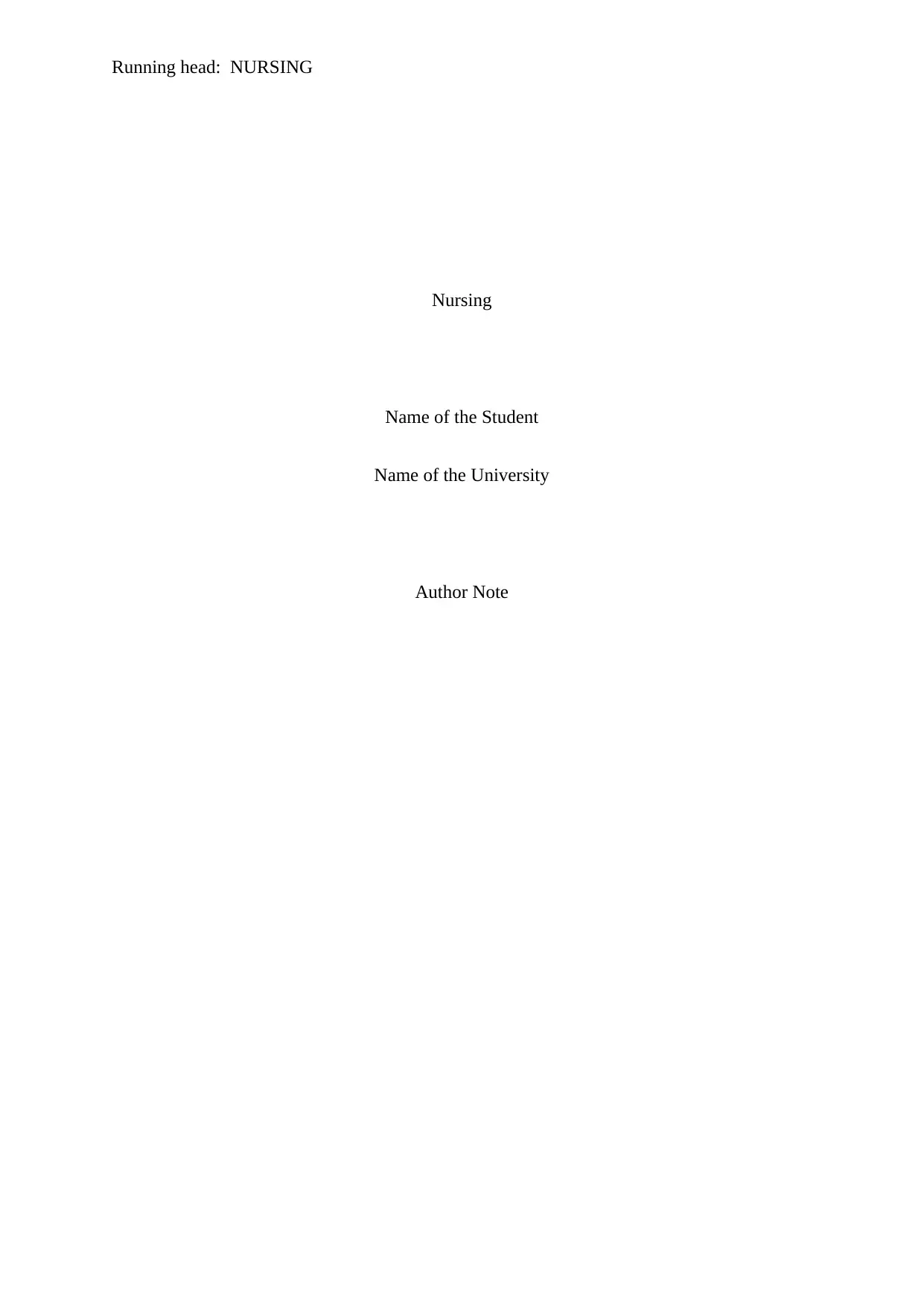
Running head: NURSING
Nursing
Name of the Student
Name of the University
Author Note
Nursing
Name of the Student
Name of the University
Author Note
Paraphrase This Document
Need a fresh take? Get an instant paraphrase of this document with our AI Paraphraser
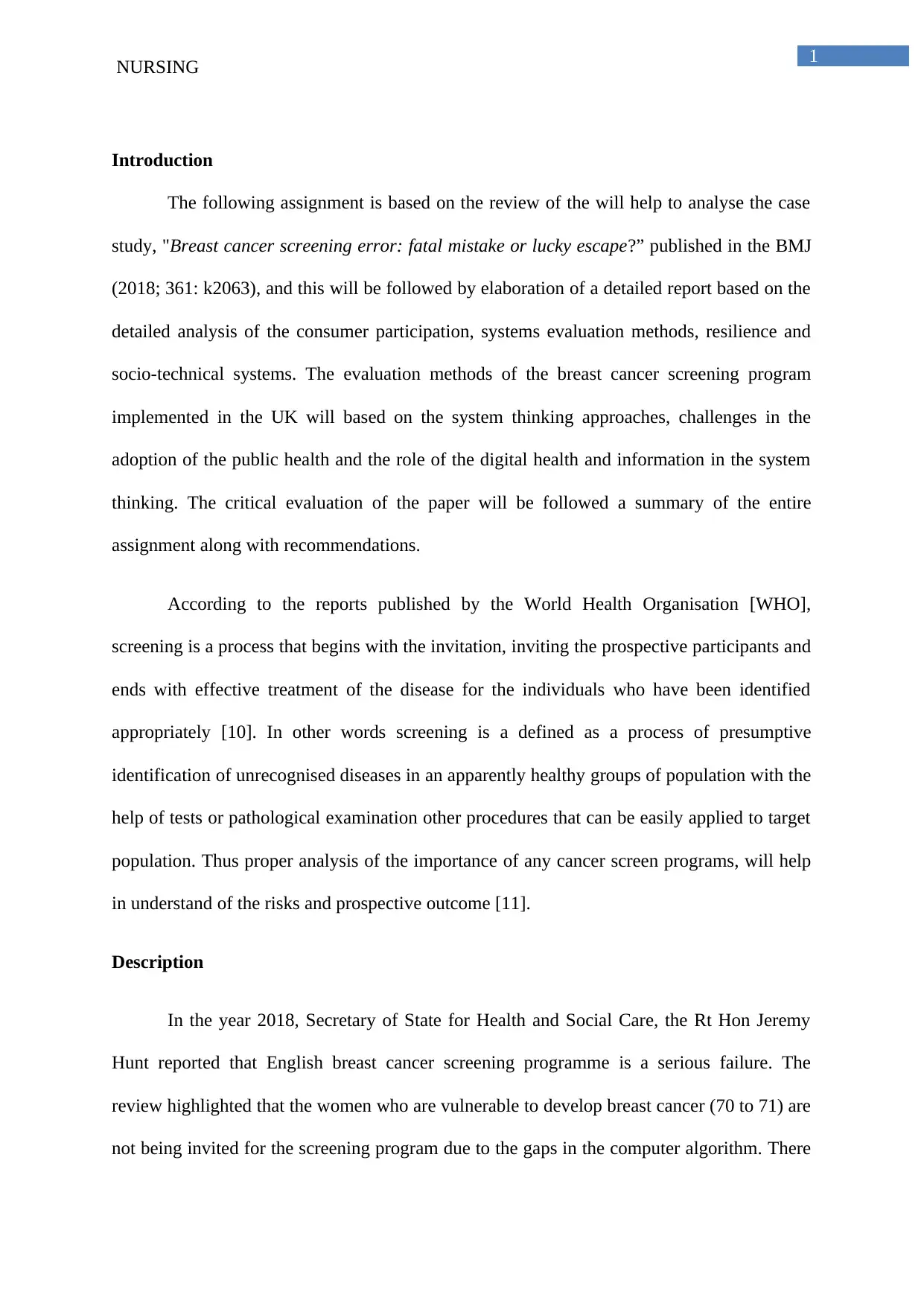
1
NURSING
Introduction
The following assignment is based on the review of the will help to analyse the case
study, "Breast cancer screening error: fatal mistake or lucky escape?” published in the BMJ
(2018; 361: k2063), and this will be followed by elaboration of a detailed report based on the
detailed analysis of the consumer participation, systems evaluation methods, resilience and
socio-technical systems. The evaluation methods of the breast cancer screening program
implemented in the UK will based on the system thinking approaches, challenges in the
adoption of the public health and the role of the digital health and information in the system
thinking. The critical evaluation of the paper will be followed a summary of the entire
assignment along with recommendations.
According to the reports published by the World Health Organisation [WHO],
screening is a process that begins with the invitation, inviting the prospective participants and
ends with effective treatment of the disease for the individuals who have been identified
appropriately [10]. In other words screening is a defined as a process of presumptive
identification of unrecognised diseases in an apparently healthy groups of population with the
help of tests or pathological examination other procedures that can be easily applied to target
population. Thus proper analysis of the importance of any cancer screen programs, will help
in understand of the risks and prospective outcome [11].
Description
In the year 2018, Secretary of State for Health and Social Care, the Rt Hon Jeremy
Hunt reported that English breast cancer screening programme is a serious failure. The
review highlighted that the women who are vulnerable to develop breast cancer (70 to 71) are
not being invited for the screening program due to the gaps in the computer algorithm. There
NURSING
Introduction
The following assignment is based on the review of the will help to analyse the case
study, "Breast cancer screening error: fatal mistake or lucky escape?” published in the BMJ
(2018; 361: k2063), and this will be followed by elaboration of a detailed report based on the
detailed analysis of the consumer participation, systems evaluation methods, resilience and
socio-technical systems. The evaluation methods of the breast cancer screening program
implemented in the UK will based on the system thinking approaches, challenges in the
adoption of the public health and the role of the digital health and information in the system
thinking. The critical evaluation of the paper will be followed a summary of the entire
assignment along with recommendations.
According to the reports published by the World Health Organisation [WHO],
screening is a process that begins with the invitation, inviting the prospective participants and
ends with effective treatment of the disease for the individuals who have been identified
appropriately [10]. In other words screening is a defined as a process of presumptive
identification of unrecognised diseases in an apparently healthy groups of population with the
help of tests or pathological examination other procedures that can be easily applied to target
population. Thus proper analysis of the importance of any cancer screen programs, will help
in understand of the risks and prospective outcome [11].
Description
In the year 2018, Secretary of State for Health and Social Care, the Rt Hon Jeremy
Hunt reported that English breast cancer screening programme is a serious failure. The
review highlighted that the women who are vulnerable to develop breast cancer (70 to 71) are
not being invited for the screening program due to the gaps in the computer algorithm. There
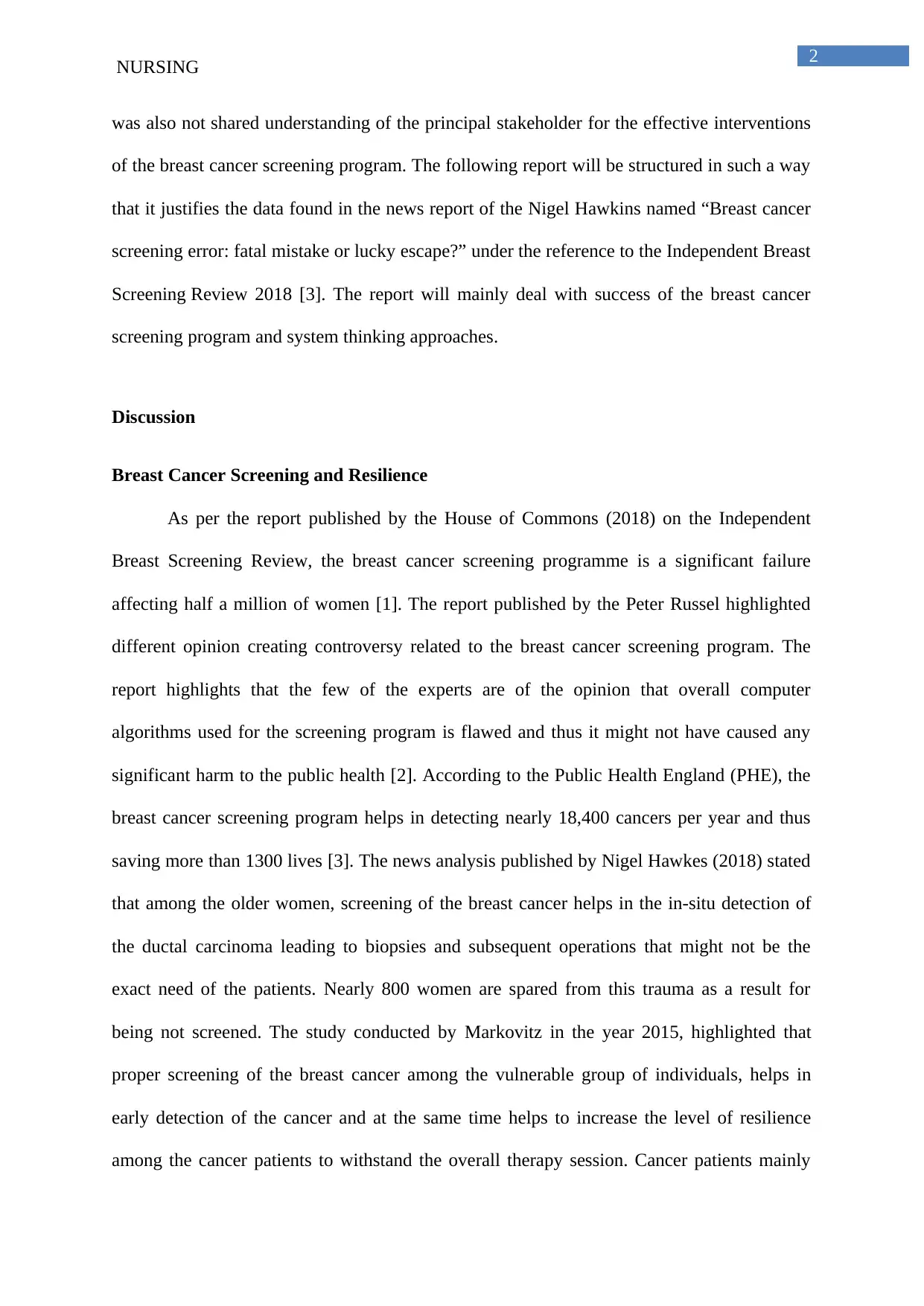
2
NURSING
was also not shared understanding of the principal stakeholder for the effective interventions
of the breast cancer screening program. The following report will be structured in such a way
that it justifies the data found in the news report of the Nigel Hawkins named “Breast cancer
screening error: fatal mistake or lucky escape?” under the reference to the Independent Breast
Screening Review 2018 [3]. The report will mainly deal with success of the breast cancer
screening program and system thinking approaches.
Discussion
Breast Cancer Screening and Resilience
As per the report published by the House of Commons (2018) on the Independent
Breast Screening Review, the breast cancer screening programme is a significant failure
affecting half a million of women [1]. The report published by the Peter Russel highlighted
different opinion creating controversy related to the breast cancer screening program. The
report highlights that the few of the experts are of the opinion that overall computer
algorithms used for the screening program is flawed and thus it might not have caused any
significant harm to the public health [2]. According to the Public Health England (PHE), the
breast cancer screening program helps in detecting nearly 18,400 cancers per year and thus
saving more than 1300 lives [3]. The news analysis published by Nigel Hawkes (2018) stated
that among the older women, screening of the breast cancer helps in the in-situ detection of
the ductal carcinoma leading to biopsies and subsequent operations that might not be the
exact need of the patients. Nearly 800 women are spared from this trauma as a result for
being not screened. The study conducted by Markovitz in the year 2015, highlighted that
proper screening of the breast cancer among the vulnerable group of individuals, helps in
early detection of the cancer and at the same time helps to increase the level of resilience
among the cancer patients to withstand the overall therapy session. Cancer patients mainly
NURSING
was also not shared understanding of the principal stakeholder for the effective interventions
of the breast cancer screening program. The following report will be structured in such a way
that it justifies the data found in the news report of the Nigel Hawkins named “Breast cancer
screening error: fatal mistake or lucky escape?” under the reference to the Independent Breast
Screening Review 2018 [3]. The report will mainly deal with success of the breast cancer
screening program and system thinking approaches.
Discussion
Breast Cancer Screening and Resilience
As per the report published by the House of Commons (2018) on the Independent
Breast Screening Review, the breast cancer screening programme is a significant failure
affecting half a million of women [1]. The report published by the Peter Russel highlighted
different opinion creating controversy related to the breast cancer screening program. The
report highlights that the few of the experts are of the opinion that overall computer
algorithms used for the screening program is flawed and thus it might not have caused any
significant harm to the public health [2]. According to the Public Health England (PHE), the
breast cancer screening program helps in detecting nearly 18,400 cancers per year and thus
saving more than 1300 lives [3]. The news analysis published by Nigel Hawkes (2018) stated
that among the older women, screening of the breast cancer helps in the in-situ detection of
the ductal carcinoma leading to biopsies and subsequent operations that might not be the
exact need of the patients. Nearly 800 women are spared from this trauma as a result for
being not screened. The study conducted by Markovitz in the year 2015, highlighted that
proper screening of the breast cancer among the vulnerable group of individuals, helps in
early detection of the cancer and at the same time helps to increase the level of resilience
among the cancer patients to withstand the overall therapy session. Cancer patients mainly
⊘ This is a preview!⊘
Do you want full access?
Subscribe today to unlock all pages.

Trusted by 1+ million students worldwide
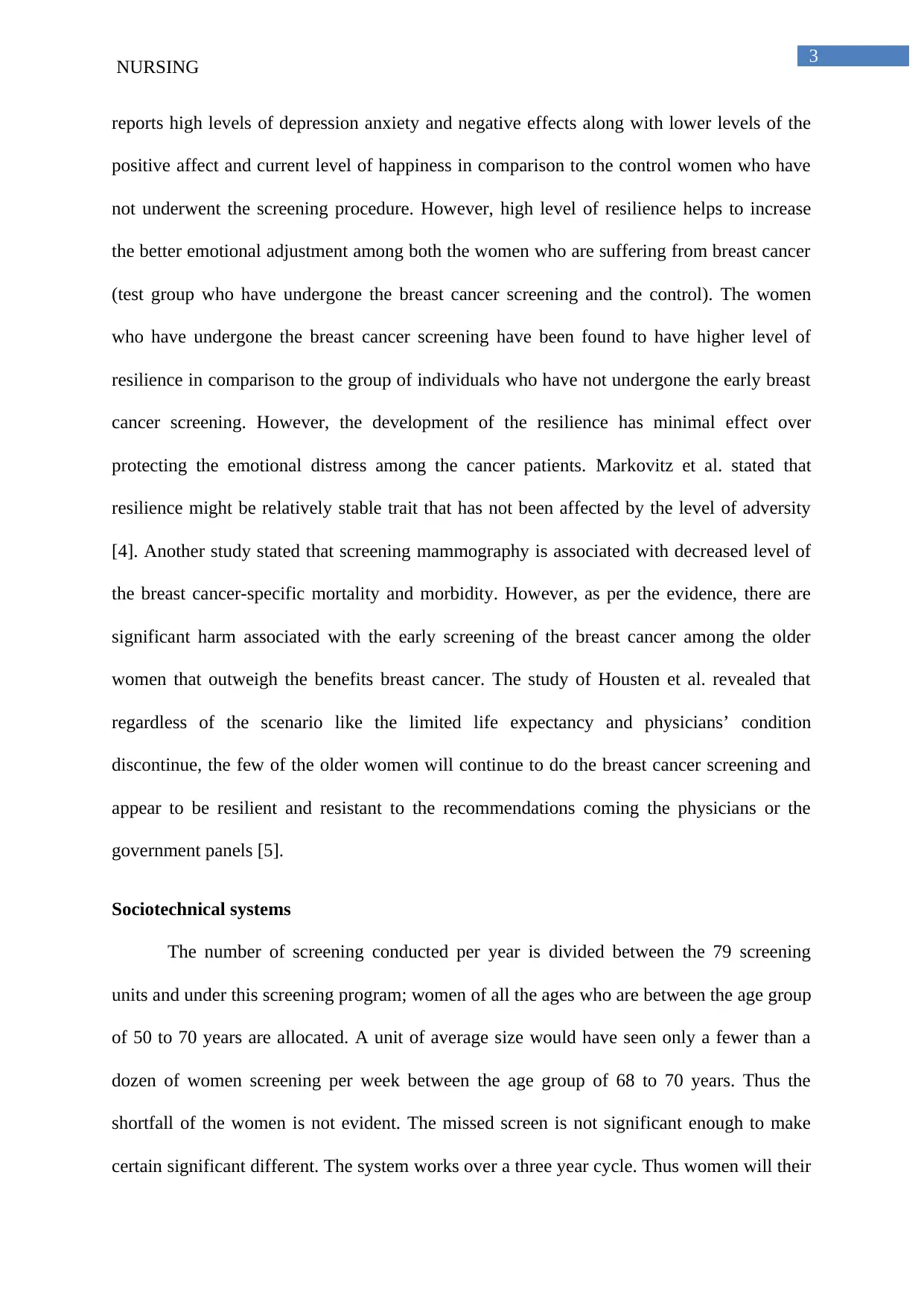
3
NURSING
reports high levels of depression anxiety and negative effects along with lower levels of the
positive affect and current level of happiness in comparison to the control women who have
not underwent the screening procedure. However, high level of resilience helps to increase
the better emotional adjustment among both the women who are suffering from breast cancer
(test group who have undergone the breast cancer screening and the control). The women
who have undergone the breast cancer screening have been found to have higher level of
resilience in comparison to the group of individuals who have not undergone the early breast
cancer screening. However, the development of the resilience has minimal effect over
protecting the emotional distress among the cancer patients. Markovitz et al. stated that
resilience might be relatively stable trait that has not been affected by the level of adversity
[4]. Another study stated that screening mammography is associated with decreased level of
the breast cancer-specific mortality and morbidity. However, as per the evidence, there are
significant harm associated with the early screening of the breast cancer among the older
women that outweigh the benefits breast cancer. The study of Housten et al. revealed that
regardless of the scenario like the limited life expectancy and physicians’ condition
discontinue, the few of the older women will continue to do the breast cancer screening and
appear to be resilient and resistant to the recommendations coming the physicians or the
government panels [5].
Sociotechnical systems
The number of screening conducted per year is divided between the 79 screening
units and under this screening program; women of all the ages who are between the age group
of 50 to 70 years are allocated. A unit of average size would have seen only a fewer than a
dozen of women screening per week between the age group of 68 to 70 years. Thus the
shortfall of the women is not evident. The missed screen is not significant enough to make
certain significant different. The system works over a three year cycle. Thus women will their
NURSING
reports high levels of depression anxiety and negative effects along with lower levels of the
positive affect and current level of happiness in comparison to the control women who have
not underwent the screening procedure. However, high level of resilience helps to increase
the better emotional adjustment among both the women who are suffering from breast cancer
(test group who have undergone the breast cancer screening and the control). The women
who have undergone the breast cancer screening have been found to have higher level of
resilience in comparison to the group of individuals who have not undergone the early breast
cancer screening. However, the development of the resilience has minimal effect over
protecting the emotional distress among the cancer patients. Markovitz et al. stated that
resilience might be relatively stable trait that has not been affected by the level of adversity
[4]. Another study stated that screening mammography is associated with decreased level of
the breast cancer-specific mortality and morbidity. However, as per the evidence, there are
significant harm associated with the early screening of the breast cancer among the older
women that outweigh the benefits breast cancer. The study of Housten et al. revealed that
regardless of the scenario like the limited life expectancy and physicians’ condition
discontinue, the few of the older women will continue to do the breast cancer screening and
appear to be resilient and resistant to the recommendations coming the physicians or the
government panels [5].
Sociotechnical systems
The number of screening conducted per year is divided between the 79 screening
units and under this screening program; women of all the ages who are between the age group
of 50 to 70 years are allocated. A unit of average size would have seen only a fewer than a
dozen of women screening per week between the age group of 68 to 70 years. Thus the
shortfall of the women is not evident. The missed screen is not significant enough to make
certain significant different. The system works over a three year cycle. Thus women will their
Paraphrase This Document
Need a fresh take? Get an instant paraphrase of this document with our AI Paraphraser
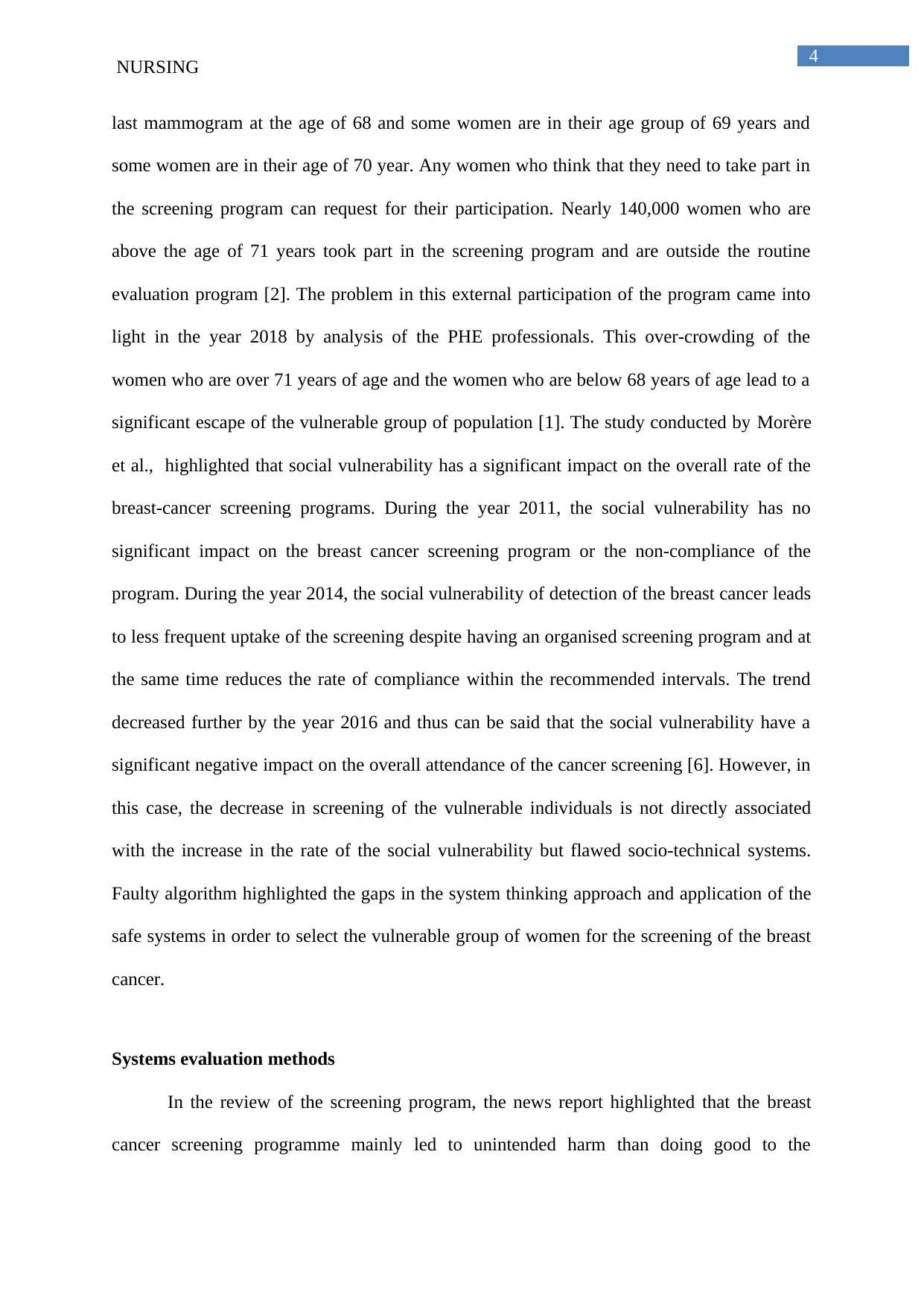
4
NURSING
last mammogram at the age of 68 and some women are in their age group of 69 years and
some women are in their age of 70 year. Any women who think that they need to take part in
the screening program can request for their participation. Nearly 140,000 women who are
above the age of 71 years took part in the screening program and are outside the routine
evaluation program [2]. The problem in this external participation of the program came into
light in the year 2018 by analysis of the PHE professionals. This over-crowding of the
women who are over 71 years of age and the women who are below 68 years of age lead to a
significant escape of the vulnerable group of population [1]. The study conducted by Morère
et al., highlighted that social vulnerability has a significant impact on the overall rate of the
breast-cancer screening programs. During the year 2011, the social vulnerability has no
significant impact on the breast cancer screening program or the non-compliance of the
program. During the year 2014, the social vulnerability of detection of the breast cancer leads
to less frequent uptake of the screening despite having an organised screening program and at
the same time reduces the rate of compliance within the recommended intervals. The trend
decreased further by the year 2016 and thus can be said that the social vulnerability have a
significant negative impact on the overall attendance of the cancer screening [6]. However, in
this case, the decrease in screening of the vulnerable individuals is not directly associated
with the increase in the rate of the social vulnerability but flawed socio-technical systems.
Faulty algorithm highlighted the gaps in the system thinking approach and application of the
safe systems in order to select the vulnerable group of women for the screening of the breast
cancer.
Systems evaluation methods
In the review of the screening program, the news report highlighted that the breast
cancer screening programme mainly led to unintended harm than doing good to the
NURSING
last mammogram at the age of 68 and some women are in their age group of 69 years and
some women are in their age of 70 year. Any women who think that they need to take part in
the screening program can request for their participation. Nearly 140,000 women who are
above the age of 71 years took part in the screening program and are outside the routine
evaluation program [2]. The problem in this external participation of the program came into
light in the year 2018 by analysis of the PHE professionals. This over-crowding of the
women who are over 71 years of age and the women who are below 68 years of age lead to a
significant escape of the vulnerable group of population [1]. The study conducted by Morère
et al., highlighted that social vulnerability has a significant impact on the overall rate of the
breast-cancer screening programs. During the year 2011, the social vulnerability has no
significant impact on the breast cancer screening program or the non-compliance of the
program. During the year 2014, the social vulnerability of detection of the breast cancer leads
to less frequent uptake of the screening despite having an organised screening program and at
the same time reduces the rate of compliance within the recommended intervals. The trend
decreased further by the year 2016 and thus can be said that the social vulnerability have a
significant negative impact on the overall attendance of the cancer screening [6]. However, in
this case, the decrease in screening of the vulnerable individuals is not directly associated
with the increase in the rate of the social vulnerability but flawed socio-technical systems.
Faulty algorithm highlighted the gaps in the system thinking approach and application of the
safe systems in order to select the vulnerable group of women for the screening of the breast
cancer.
Systems evaluation methods
In the review of the screening program, the news report highlighted that the breast
cancer screening programme mainly led to unintended harm than doing good to the
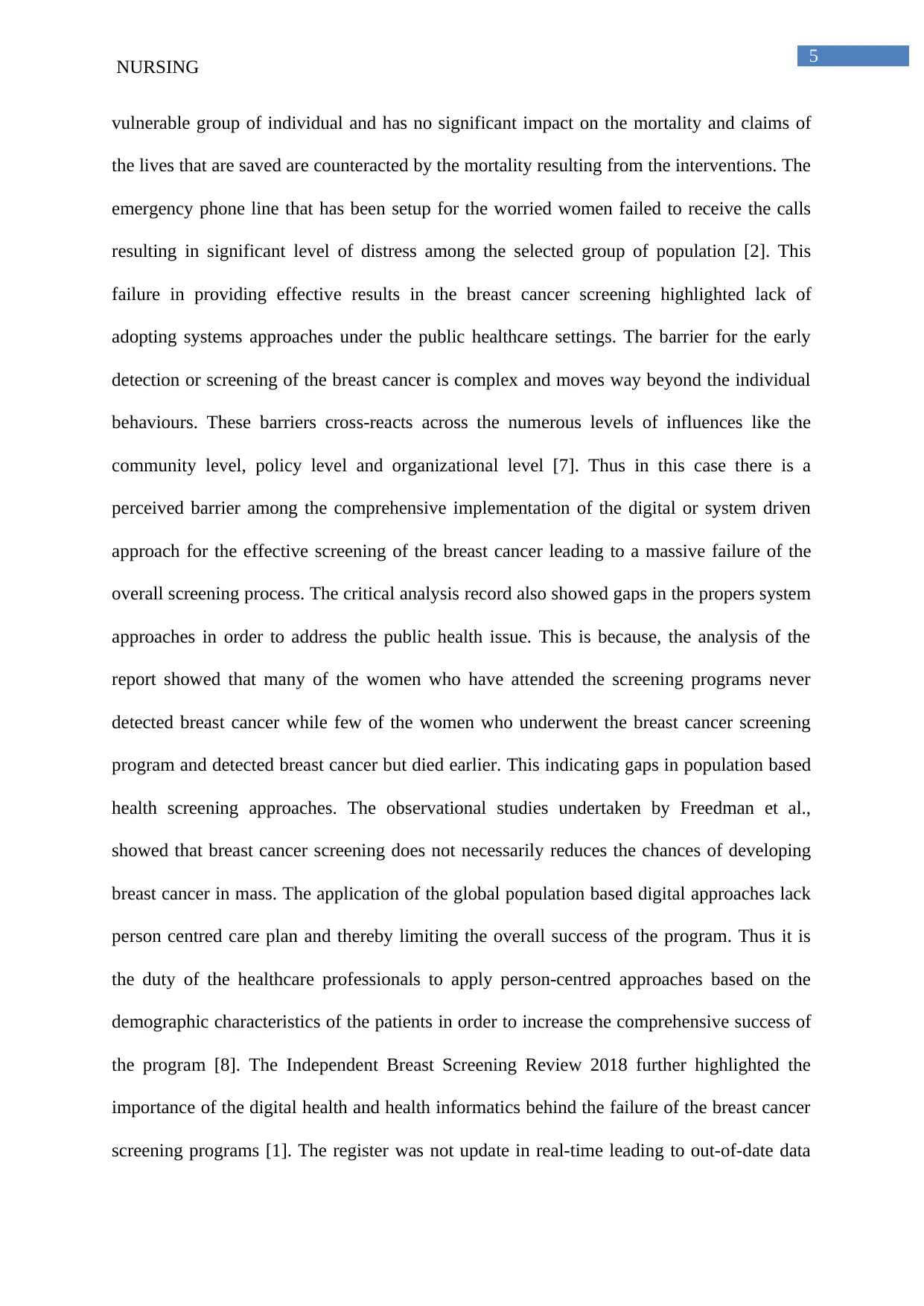
5
NURSING
vulnerable group of individual and has no significant impact on the mortality and claims of
the lives that are saved are counteracted by the mortality resulting from the interventions. The
emergency phone line that has been setup for the worried women failed to receive the calls
resulting in significant level of distress among the selected group of population [2]. This
failure in providing effective results in the breast cancer screening highlighted lack of
adopting systems approaches under the public healthcare settings. The barrier for the early
detection or screening of the breast cancer is complex and moves way beyond the individual
behaviours. These barriers cross-reacts across the numerous levels of influences like the
community level, policy level and organizational level [7]. Thus in this case there is a
perceived barrier among the comprehensive implementation of the digital or system driven
approach for the effective screening of the breast cancer leading to a massive failure of the
overall screening process. The critical analysis record also showed gaps in the propers system
approaches in order to address the public health issue. This is because, the analysis of the
report showed that many of the women who have attended the screening programs never
detected breast cancer while few of the women who underwent the breast cancer screening
program and detected breast cancer but died earlier. This indicating gaps in population based
health screening approaches. The observational studies undertaken by Freedman et al.,
showed that breast cancer screening does not necessarily reduces the chances of developing
breast cancer in mass. The application of the global population based digital approaches lack
person centred care plan and thereby limiting the overall success of the program. Thus it is
the duty of the healthcare professionals to apply person-centred approaches based on the
demographic characteristics of the patients in order to increase the comprehensive success of
the program [8]. The Independent Breast Screening Review 2018 further highlighted the
importance of the digital health and health informatics behind the failure of the breast cancer
screening programs [1]. The register was not update in real-time leading to out-of-date data
NURSING
vulnerable group of individual and has no significant impact on the mortality and claims of
the lives that are saved are counteracted by the mortality resulting from the interventions. The
emergency phone line that has been setup for the worried women failed to receive the calls
resulting in significant level of distress among the selected group of population [2]. This
failure in providing effective results in the breast cancer screening highlighted lack of
adopting systems approaches under the public healthcare settings. The barrier for the early
detection or screening of the breast cancer is complex and moves way beyond the individual
behaviours. These barriers cross-reacts across the numerous levels of influences like the
community level, policy level and organizational level [7]. Thus in this case there is a
perceived barrier among the comprehensive implementation of the digital or system driven
approach for the effective screening of the breast cancer leading to a massive failure of the
overall screening process. The critical analysis record also showed gaps in the propers system
approaches in order to address the public health issue. This is because, the analysis of the
report showed that many of the women who have attended the screening programs never
detected breast cancer while few of the women who underwent the breast cancer screening
program and detected breast cancer but died earlier. This indicating gaps in population based
health screening approaches. The observational studies undertaken by Freedman et al.,
showed that breast cancer screening does not necessarily reduces the chances of developing
breast cancer in mass. The application of the global population based digital approaches lack
person centred care plan and thereby limiting the overall success of the program. Thus it is
the duty of the healthcare professionals to apply person-centred approaches based on the
demographic characteristics of the patients in order to increase the comprehensive success of
the program [8]. The Independent Breast Screening Review 2018 further highlighted the
importance of the digital health and health informatics behind the failure of the breast cancer
screening programs [1]. The register was not update in real-time leading to out-of-date data
⊘ This is a preview!⊘
Do you want full access?
Subscribe today to unlock all pages.

Trusted by 1+ million students worldwide
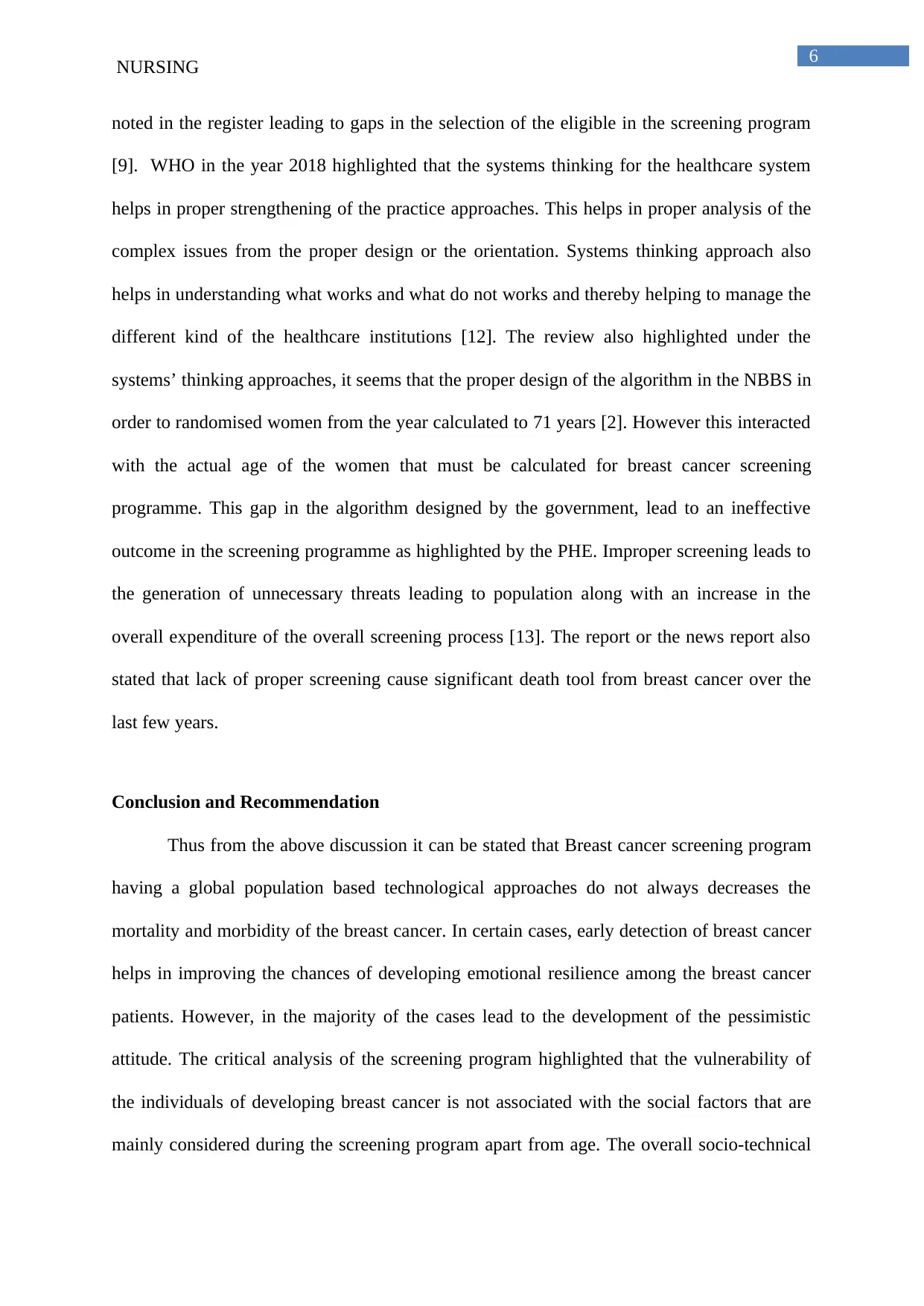
6
NURSING
noted in the register leading to gaps in the selection of the eligible in the screening program
[9]. WHO in the year 2018 highlighted that the systems thinking for the healthcare system
helps in proper strengthening of the practice approaches. This helps in proper analysis of the
complex issues from the proper design or the orientation. Systems thinking approach also
helps in understanding what works and what do not works and thereby helping to manage the
different kind of the healthcare institutions [12]. The review also highlighted under the
systems’ thinking approaches, it seems that the proper design of the algorithm in the NBBS in
order to randomised women from the year calculated to 71 years [2]. However this interacted
with the actual age of the women that must be calculated for breast cancer screening
programme. This gap in the algorithm designed by the government, lead to an ineffective
outcome in the screening programme as highlighted by the PHE. Improper screening leads to
the generation of unnecessary threats leading to population along with an increase in the
overall expenditure of the overall screening process [13]. The report or the news report also
stated that lack of proper screening cause significant death tool from breast cancer over the
last few years.
Conclusion and Recommendation
Thus from the above discussion it can be stated that Breast cancer screening program
having a global population based technological approaches do not always decreases the
mortality and morbidity of the breast cancer. In certain cases, early detection of breast cancer
helps in improving the chances of developing emotional resilience among the breast cancer
patients. However, in the majority of the cases lead to the development of the pessimistic
attitude. The critical analysis of the screening program highlighted that the vulnerability of
the individuals of developing breast cancer is not associated with the social factors that are
mainly considered during the screening program apart from age. The overall socio-technical
NURSING
noted in the register leading to gaps in the selection of the eligible in the screening program
[9]. WHO in the year 2018 highlighted that the systems thinking for the healthcare system
helps in proper strengthening of the practice approaches. This helps in proper analysis of the
complex issues from the proper design or the orientation. Systems thinking approach also
helps in understanding what works and what do not works and thereby helping to manage the
different kind of the healthcare institutions [12]. The review also highlighted under the
systems’ thinking approaches, it seems that the proper design of the algorithm in the NBBS in
order to randomised women from the year calculated to 71 years [2]. However this interacted
with the actual age of the women that must be calculated for breast cancer screening
programme. This gap in the algorithm designed by the government, lead to an ineffective
outcome in the screening programme as highlighted by the PHE. Improper screening leads to
the generation of unnecessary threats leading to population along with an increase in the
overall expenditure of the overall screening process [13]. The report or the news report also
stated that lack of proper screening cause significant death tool from breast cancer over the
last few years.
Conclusion and Recommendation
Thus from the above discussion it can be stated that Breast cancer screening program
having a global population based technological approaches do not always decreases the
mortality and morbidity of the breast cancer. In certain cases, early detection of breast cancer
helps in improving the chances of developing emotional resilience among the breast cancer
patients. However, in the majority of the cases lead to the development of the pessimistic
attitude. The critical analysis of the screening program highlighted that the vulnerability of
the individuals of developing breast cancer is not associated with the social factors that are
mainly considered during the screening program apart from age. The overall socio-technical
Paraphrase This Document
Need a fresh take? Get an instant paraphrase of this document with our AI Paraphraser
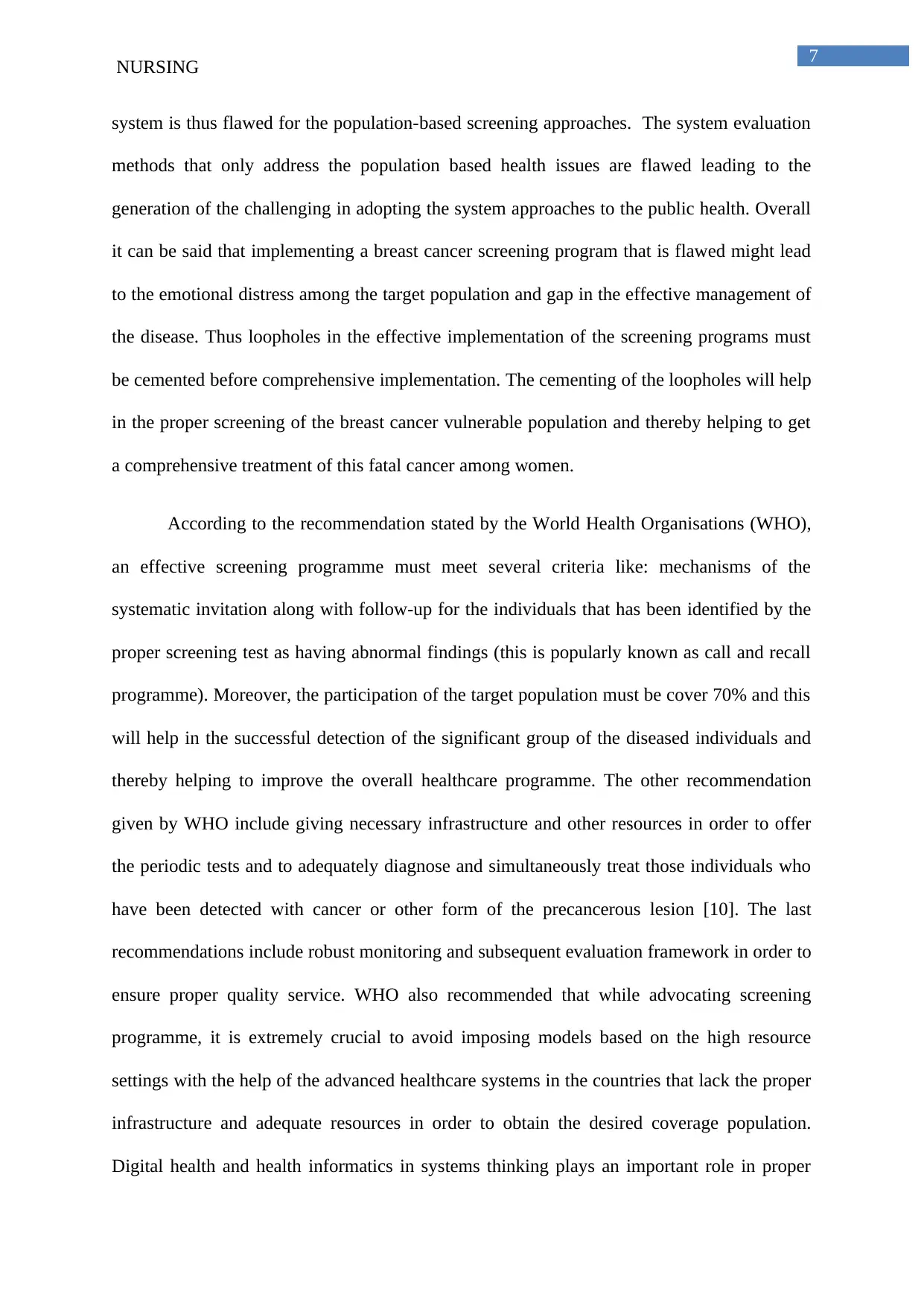
7
NURSING
system is thus flawed for the population-based screening approaches. The system evaluation
methods that only address the population based health issues are flawed leading to the
generation of the challenging in adopting the system approaches to the public health. Overall
it can be said that implementing a breast cancer screening program that is flawed might lead
to the emotional distress among the target population and gap in the effective management of
the disease. Thus loopholes in the effective implementation of the screening programs must
be cemented before comprehensive implementation. The cementing of the loopholes will help
in the proper screening of the breast cancer vulnerable population and thereby helping to get
a comprehensive treatment of this fatal cancer among women.
According to the recommendation stated by the World Health Organisations (WHO),
an effective screening programme must meet several criteria like: mechanisms of the
systematic invitation along with follow-up for the individuals that has been identified by the
proper screening test as having abnormal findings (this is popularly known as call and recall
programme). Moreover, the participation of the target population must be cover 70% and this
will help in the successful detection of the significant group of the diseased individuals and
thereby helping to improve the overall healthcare programme. The other recommendation
given by WHO include giving necessary infrastructure and other resources in order to offer
the periodic tests and to adequately diagnose and simultaneously treat those individuals who
have been detected with cancer or other form of the precancerous lesion [10]. The last
recommendations include robust monitoring and subsequent evaluation framework in order to
ensure proper quality service. WHO also recommended that while advocating screening
programme, it is extremely crucial to avoid imposing models based on the high resource
settings with the help of the advanced healthcare systems in the countries that lack the proper
infrastructure and adequate resources in order to obtain the desired coverage population.
Digital health and health informatics in systems thinking plays an important role in proper
NURSING
system is thus flawed for the population-based screening approaches. The system evaluation
methods that only address the population based health issues are flawed leading to the
generation of the challenging in adopting the system approaches to the public health. Overall
it can be said that implementing a breast cancer screening program that is flawed might lead
to the emotional distress among the target population and gap in the effective management of
the disease. Thus loopholes in the effective implementation of the screening programs must
be cemented before comprehensive implementation. The cementing of the loopholes will help
in the proper screening of the breast cancer vulnerable population and thereby helping to get
a comprehensive treatment of this fatal cancer among women.
According to the recommendation stated by the World Health Organisations (WHO),
an effective screening programme must meet several criteria like: mechanisms of the
systematic invitation along with follow-up for the individuals that has been identified by the
proper screening test as having abnormal findings (this is popularly known as call and recall
programme). Moreover, the participation of the target population must be cover 70% and this
will help in the successful detection of the significant group of the diseased individuals and
thereby helping to improve the overall healthcare programme. The other recommendation
given by WHO include giving necessary infrastructure and other resources in order to offer
the periodic tests and to adequately diagnose and simultaneously treat those individuals who
have been detected with cancer or other form of the precancerous lesion [10]. The last
recommendations include robust monitoring and subsequent evaluation framework in order to
ensure proper quality service. WHO also recommended that while advocating screening
programme, it is extremely crucial to avoid imposing models based on the high resource
settings with the help of the advanced healthcare systems in the countries that lack the proper
infrastructure and adequate resources in order to obtain the desired coverage population.
Digital health and health informatics in systems thinking plays an important role in proper
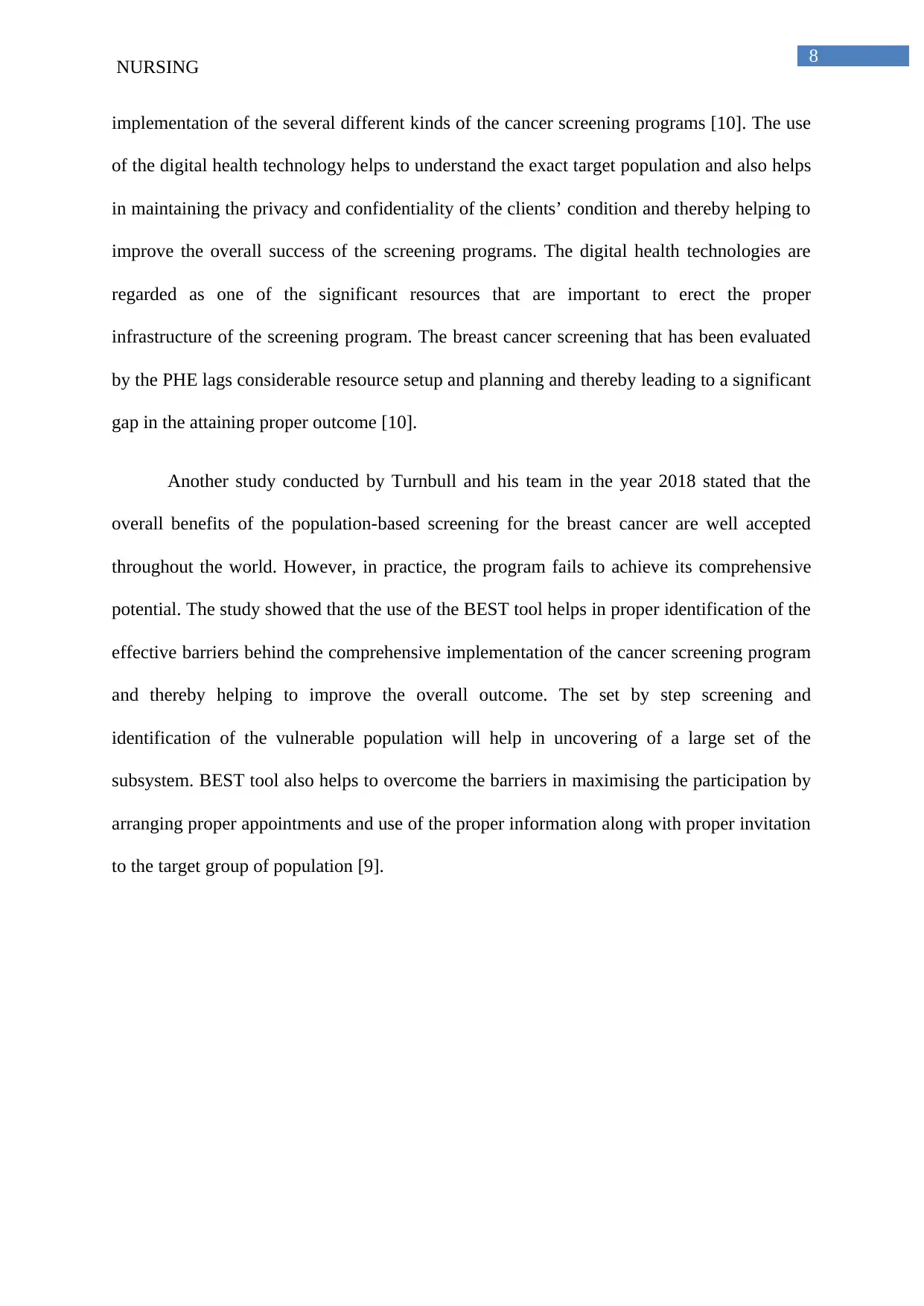
8
NURSING
implementation of the several different kinds of the cancer screening programs [10]. The use
of the digital health technology helps to understand the exact target population and also helps
in maintaining the privacy and confidentiality of the clients’ condition and thereby helping to
improve the overall success of the screening programs. The digital health technologies are
regarded as one of the significant resources that are important to erect the proper
infrastructure of the screening program. The breast cancer screening that has been evaluated
by the PHE lags considerable resource setup and planning and thereby leading to a significant
gap in the attaining proper outcome [10].
Another study conducted by Turnbull and his team in the year 2018 stated that the
overall benefits of the population-based screening for the breast cancer are well accepted
throughout the world. However, in practice, the program fails to achieve its comprehensive
potential. The study showed that the use of the BEST tool helps in proper identification of the
effective barriers behind the comprehensive implementation of the cancer screening program
and thereby helping to improve the overall outcome. The set by step screening and
identification of the vulnerable population will help in uncovering of a large set of the
subsystem. BEST tool also helps to overcome the barriers in maximising the participation by
arranging proper appointments and use of the proper information along with proper invitation
to the target group of population [9].
NURSING
implementation of the several different kinds of the cancer screening programs [10]. The use
of the digital health technology helps to understand the exact target population and also helps
in maintaining the privacy and confidentiality of the clients’ condition and thereby helping to
improve the overall success of the screening programs. The digital health technologies are
regarded as one of the significant resources that are important to erect the proper
infrastructure of the screening program. The breast cancer screening that has been evaluated
by the PHE lags considerable resource setup and planning and thereby leading to a significant
gap in the attaining proper outcome [10].
Another study conducted by Turnbull and his team in the year 2018 stated that the
overall benefits of the population-based screening for the breast cancer are well accepted
throughout the world. However, in practice, the program fails to achieve its comprehensive
potential. The study showed that the use of the BEST tool helps in proper identification of the
effective barriers behind the comprehensive implementation of the cancer screening program
and thereby helping to improve the overall outcome. The set by step screening and
identification of the vulnerable population will help in uncovering of a large set of the
subsystem. BEST tool also helps to overcome the barriers in maximising the participation by
arranging proper appointments and use of the proper information along with proper invitation
to the target group of population [9].
⊘ This is a preview!⊘
Do you want full access?
Subscribe today to unlock all pages.

Trusted by 1+ million students worldwide
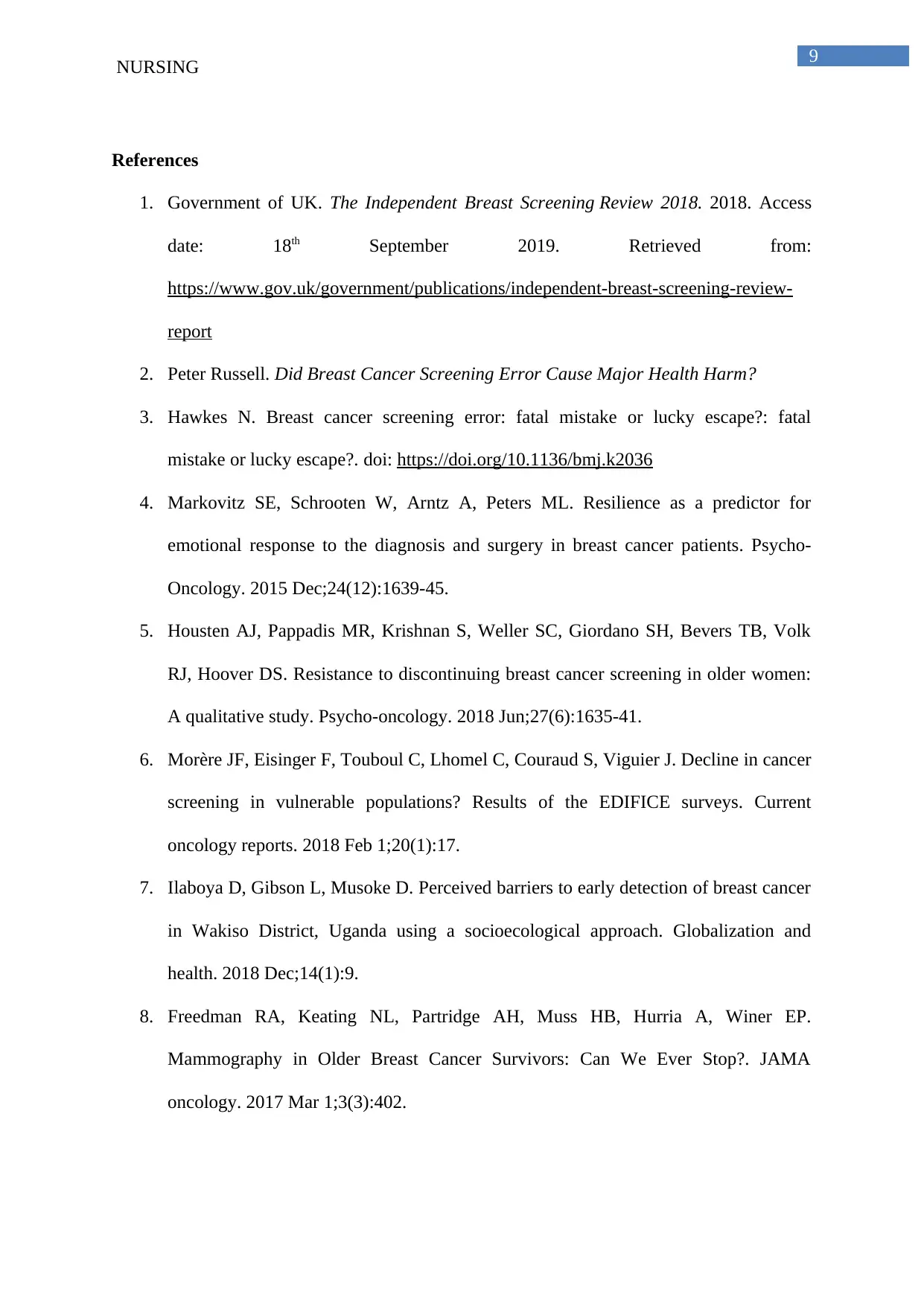
9
NURSING
References
1. Government of UK. The Independent Breast Screening Review 2018. 2018. Access
date: 18th September 2019. Retrieved from:
https://www.gov.uk/government/publications/independent-breast-screening-review-
report
2. Peter Russell. Did Breast Cancer Screening Error Cause Major Health Harm?
3. Hawkes N. Breast cancer screening error: fatal mistake or lucky escape?: fatal
mistake or lucky escape?. doi: https://doi.org/10.1136/bmj.k2036
4. Markovitz SE, Schrooten W, Arntz A, Peters ML. Resilience as a predictor for
emotional response to the diagnosis and surgery in breast cancer patients. Psycho‐
Oncology. 2015 Dec;24(12):1639-45.
5. Housten AJ, Pappadis MR, Krishnan S, Weller SC, Giordano SH, Bevers TB, Volk
RJ, Hoover DS. Resistance to discontinuing breast cancer screening in older women:
A qualitative study. Psycho‐oncology. 2018 Jun;27(6):1635-41.
6. Morère JF, Eisinger F, Touboul C, Lhomel C, Couraud S, Viguier J. Decline in cancer
screening in vulnerable populations? Results of the EDIFICE surveys. Current
oncology reports. 2018 Feb 1;20(1):17.
7. Ilaboya D, Gibson L, Musoke D. Perceived barriers to early detection of breast cancer
in Wakiso District, Uganda using a socioecological approach. Globalization and
health. 2018 Dec;14(1):9.
8. Freedman RA, Keating NL, Partridge AH, Muss HB, Hurria A, Winer EP.
Mammography in Older Breast Cancer Survivors: Can We Ever Stop?. JAMA
oncology. 2017 Mar 1;3(3):402.
NURSING
References
1. Government of UK. The Independent Breast Screening Review 2018. 2018. Access
date: 18th September 2019. Retrieved from:
https://www.gov.uk/government/publications/independent-breast-screening-review-
report
2. Peter Russell. Did Breast Cancer Screening Error Cause Major Health Harm?
3. Hawkes N. Breast cancer screening error: fatal mistake or lucky escape?: fatal
mistake or lucky escape?. doi: https://doi.org/10.1136/bmj.k2036
4. Markovitz SE, Schrooten W, Arntz A, Peters ML. Resilience as a predictor for
emotional response to the diagnosis and surgery in breast cancer patients. Psycho‐
Oncology. 2015 Dec;24(12):1639-45.
5. Housten AJ, Pappadis MR, Krishnan S, Weller SC, Giordano SH, Bevers TB, Volk
RJ, Hoover DS. Resistance to discontinuing breast cancer screening in older women:
A qualitative study. Psycho‐oncology. 2018 Jun;27(6):1635-41.
6. Morère JF, Eisinger F, Touboul C, Lhomel C, Couraud S, Viguier J. Decline in cancer
screening in vulnerable populations? Results of the EDIFICE surveys. Current
oncology reports. 2018 Feb 1;20(1):17.
7. Ilaboya D, Gibson L, Musoke D. Perceived barriers to early detection of breast cancer
in Wakiso District, Uganda using a socioecological approach. Globalization and
health. 2018 Dec;14(1):9.
8. Freedman RA, Keating NL, Partridge AH, Muss HB, Hurria A, Winer EP.
Mammography in Older Breast Cancer Survivors: Can We Ever Stop?. JAMA
oncology. 2017 Mar 1;3(3):402.
Paraphrase This Document
Need a fresh take? Get an instant paraphrase of this document with our AI Paraphraser
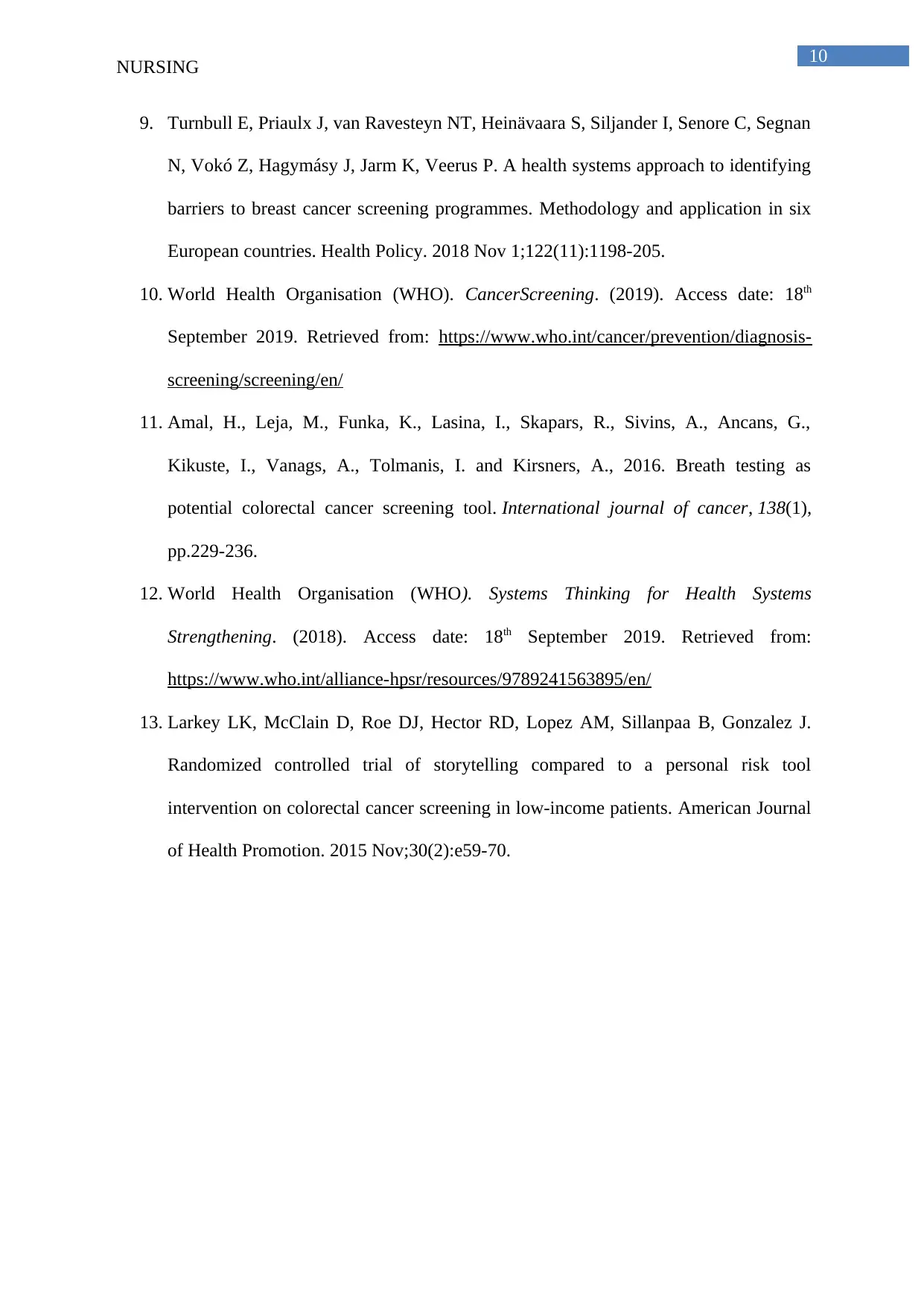
10
NURSING
9. Turnbull E, Priaulx J, van Ravesteyn NT, Heinävaara S, Siljander I, Senore C, Segnan
N, Vokó Z, Hagymásy J, Jarm K, Veerus P. A health systems approach to identifying
barriers to breast cancer screening programmes. Methodology and application in six
European countries. Health Policy. 2018 Nov 1;122(11):1198-205.
10. World Health Organisation (WHO). CancerScreening. (2019). Access date: 18th
September 2019. Retrieved from: https://www.who.int/cancer/prevention/diagnosis-
screening/screening/en/
11. Amal, H., Leja, M., Funka, K., Lasina, I., Skapars, R., Sivins, A., Ancans, G.,
Kikuste, I., Vanags, A., Tolmanis, I. and Kirsners, A., 2016. Breath testing as
potential colorectal cancer screening tool. International journal of cancer, 138(1),
pp.229-236.
12. World Health Organisation (WHO). Systems Thinking for Health Systems
Strengthening. (2018). Access date: 18th September 2019. Retrieved from:
https://www.who.int/alliance-hpsr/resources/9789241563895/en/
13. Larkey LK, McClain D, Roe DJ, Hector RD, Lopez AM, Sillanpaa B, Gonzalez J.
Randomized controlled trial of storytelling compared to a personal risk tool
intervention on colorectal cancer screening in low-income patients. American Journal
of Health Promotion. 2015 Nov;30(2):e59-70.
NURSING
9. Turnbull E, Priaulx J, van Ravesteyn NT, Heinävaara S, Siljander I, Senore C, Segnan
N, Vokó Z, Hagymásy J, Jarm K, Veerus P. A health systems approach to identifying
barriers to breast cancer screening programmes. Methodology and application in six
European countries. Health Policy. 2018 Nov 1;122(11):1198-205.
10. World Health Organisation (WHO). CancerScreening. (2019). Access date: 18th
September 2019. Retrieved from: https://www.who.int/cancer/prevention/diagnosis-
screening/screening/en/
11. Amal, H., Leja, M., Funka, K., Lasina, I., Skapars, R., Sivins, A., Ancans, G.,
Kikuste, I., Vanags, A., Tolmanis, I. and Kirsners, A., 2016. Breath testing as
potential colorectal cancer screening tool. International journal of cancer, 138(1),
pp.229-236.
12. World Health Organisation (WHO). Systems Thinking for Health Systems
Strengthening. (2018). Access date: 18th September 2019. Retrieved from:
https://www.who.int/alliance-hpsr/resources/9789241563895/en/
13. Larkey LK, McClain D, Roe DJ, Hector RD, Lopez AM, Sillanpaa B, Gonzalez J.
Randomized controlled trial of storytelling compared to a personal risk tool
intervention on colorectal cancer screening in low-income patients. American Journal
of Health Promotion. 2015 Nov;30(2):e59-70.
1 out of 11
Your All-in-One AI-Powered Toolkit for Academic Success.
+13062052269
info@desklib.com
Available 24*7 on WhatsApp / Email
![[object Object]](/_next/static/media/star-bottom.7253800d.svg)
Unlock your academic potential
Copyright © 2020–2025 A2Z Services. All Rights Reserved. Developed and managed by ZUCOL.


